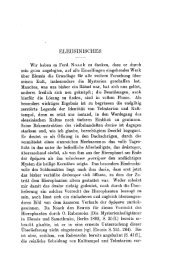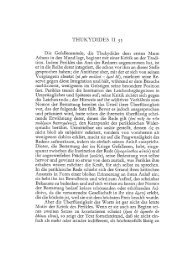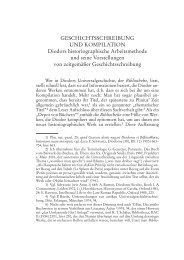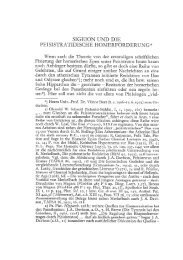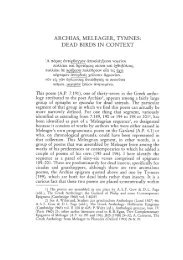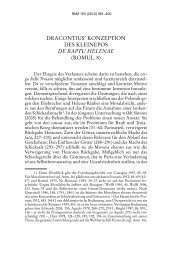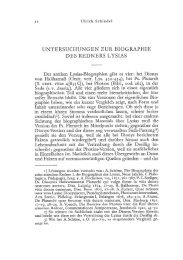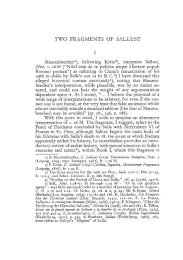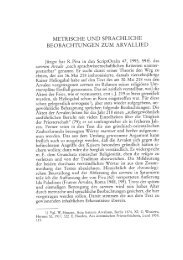VIRGILIO E STESICORO Una ricerca sulla Tabula Iliaca Capitolina *
VIRGILIO E STESICORO Una ricerca sulla Tabula Iliaca Capitolina *
VIRGILIO E STESICORO Una ricerca sulla Tabula Iliaca Capitolina *
Sie wollen auch ein ePaper? Erhöhen Sie die Reichweite Ihrer Titel.
YUMPU macht aus Druck-PDFs automatisch weboptimierte ePaper, die Google liebt.
186 David Wardle<br />
neque ita ut sit data /columem te sistere illi and Virg. Aen. 2.620:<br />
tutum patrio te limine sistam) and omnia ut quidque infuere ita<br />
salva sistentur tibi (1359). In the categories of sisto in Lewis<br />
& Short our example probably belongs in A5 ‘to cause to be in<br />
certain condition’ and in the Oxford Latin Dictionary in (3) ‘to<br />
present (a person) or hand over (a thing) at the required time’ respectively.<br />
Which nuance we accept can only be decided by the<br />
wider context, in particular the following phrase, but there is no<br />
need to envisage a specifically legislative context. 16<br />
In sua sede. This expression has generally been understood<br />
in a metaphorical sense, 17 although both detailed commentators on<br />
this passage envisage a more concrete sense. Ceausescu argues that<br />
sedes rei publicae must be understood in the sense that it is in several<br />
of Cicero’s works and in Livy, as the city of Rome, and thus comprises<br />
a boast by Augustus of having thwarted the intention of<br />
M. Antonius to transfer the capital of the empire to Alexandria. 18 If,<br />
however, a metaphorical translation is adopted, e. g. ‘on its rightful<br />
base’, this could easily refer to constitutional and/or legislative action<br />
by Augustus, either with a general reference or even specifically<br />
to his claim rem publicam ex mea potestate in senatus populique<br />
Romani arbitrium transtuli of the events of 13th January 27 B. C., 19<br />
16) H. Grziwotz, Das Verfassungsverständnis der römischen Republik,<br />
Frankfurt 1985, 317–9 demonstrates that the expression rem publicam constituere,<br />
and thus the role of Octavian as triumvir rei publicae constituendae, did not mean<br />
creating a new constitution, but bringing to order the existing one.<br />
17) P. Burmann, C. Suetonii Tranquilli De Vita Caesarum, Amsterdam 1736:<br />
“pro firmo ac stabili rerum statu”; D. Ruhnken, Scholia in Suetonii vitas Caesarum,<br />
Leiden 1820: “firmus status rerum”; S. Pitiscus, C. Suetonii Tranquilli Opera,<br />
Frankfurt 1690: “sedes est bãsiw, krÆpiw. Translatum a columnis vel colossis, qui<br />
magno nisu in suam basim restituuntur”. But Girardet (above, n. 2) 235: “nicht<br />
metaphorisch zu verstehen”.<br />
18) Cf. Ehrenberg (above, n. 9) 115: “For Cicero Rome represented the state”.<br />
Prov. Cons. 34: Numquam haec urbs summo imperio domicilium ac sedem praebuisset;<br />
Leg. Agr. 1.18: sedem urbis atque imperii, 2.89: sedem novae rei publicae; Sull. 33:<br />
urbem hanc . . . sedem omnium nostri; Cat. 3.26: imperii domicilium sedesque;<br />
Rep. 2.10: hanc urbem sedem aliquando et domum summo esse imperio praebituram;<br />
Livy 5.51.2, 27.34.14. On Octavian’s successful propaganda campaign to persuade the<br />
Roman people that Antonius intended to move the capital, see e. g. P. Ceausescu,<br />
Altera Roma: l’histoire d’une folie politique, Historia 25, 1976, esp. 86–8.<br />
19) RG 34.1. On which see most recently W. Turpin, Res Gestae 34.1 and the<br />
Settlement of 27 B. C., CQ 44, 1994, 427–37.



